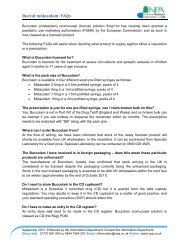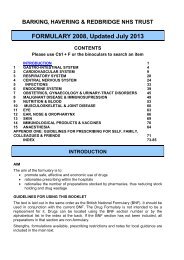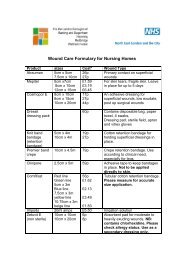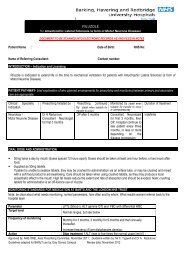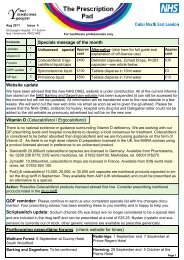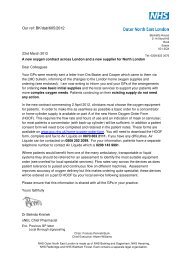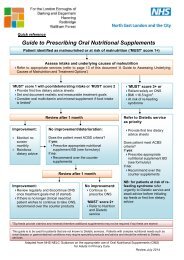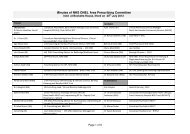Vitamin D For the prophylaxis and treatment of symptomatic vitamin ...
Vitamin D For the prophylaxis and treatment of symptomatic vitamin ...
Vitamin D For the prophylaxis and treatment of symptomatic vitamin ...
Create successful ePaper yourself
Turn your PDF publications into a flip-book with our unique Google optimized e-Paper software.
NHS ONEL <strong>and</strong> BHRuT NHS Trust Shared Care GuidelinesDRUG NAME: <strong>Vitamin</strong> D (ergocalciferol; colecalciferol)Indication/s: <strong>For</strong> <strong>the</strong> <strong>prophylaxis</strong> <strong>and</strong> <strong>treatment</strong> <strong>of</strong> <strong>symptomatic</strong> <strong>vitamin</strong> D deficiency in infants, children <strong>and</strong>adolescentsDOCUMENT TO BE SCANNED INTO ELECTRONIC RECORDS AS AND FILED IN NOTESPatient Name: Date <strong>of</strong> Birth: NHS No:Name <strong>of</strong> Referring Consultant:Contact number:INTRODUCTION AND BACKGROUND<strong>Vitamin</strong> D deficiency is common in our paediatric population. Exclusively breast-fed infants above <strong>the</strong> age <strong>of</strong> 6 months are at high riskparticularly if <strong>the</strong>ir mo<strong>the</strong>rs are <strong>vitamin</strong> D deficient <strong>and</strong> <strong>the</strong> infants are not established on wide range <strong>of</strong> solid foods. Adolescents whohave a poor diet <strong>and</strong>/or have limited sun exposure due to clothing are also vulnerable.(1,2,3,4)There has been an increased awareness <strong>of</strong> <strong>the</strong> association between <strong>vitamin</strong> D <strong>and</strong> health in young children (5)PATIENT PATHWAY- brief explanation <strong>of</strong> why planned arrangements for prescribing <strong>and</strong> monitoring between primary <strong>and</strong> secondarycare are appropriateDeveloping guidance for managing <strong>vitamin</strong> D deficiency has been complicated by <strong>the</strong> following factors:<strong>the</strong>re is a lack <strong>of</strong> consensus regarding <strong>the</strong> ideal level <strong>of</strong> <strong>vitamin</strong> D <strong>and</strong> optimum serum concentrations<strong>the</strong> evidence base is not completely defined in relation to <strong>the</strong> best management <strong>of</strong> different <strong>vitamin</strong> D deficiency states <strong>and</strong> <strong>the</strong>monitoring required following <strong>treatment</strong><strong>the</strong> availability <strong>of</strong> licensed <strong>vitamin</strong> D products is limited <strong>and</strong> unlicensed products have variable <strong>and</strong> <strong>of</strong>ten substantial costsThe majority <strong>of</strong> cases <strong>of</strong> <strong>vitamin</strong> D deficiency can be treated <strong>and</strong> prevented in primary care. The purpose <strong>of</strong> this guideline is toharmonise practice with regard to <strong>the</strong> identification, <strong>treatment</strong> <strong>and</strong> monitoring <strong>of</strong> <strong>symptomatic</strong> <strong>vitamin</strong> D deficiency <strong>and</strong> insufficiencyacross <strong>the</strong> sector <strong>and</strong> to maximise resources by focusing <strong>treatment</strong> on those patients who have or are at most risk from <strong>vitamin</strong> Ddeficiency related disease. The products listed within this guideline represent <strong>the</strong> best choices in terms <strong>of</strong> quality, availability <strong>and</strong> cost.The preparation prescribed in <strong>the</strong> secondary care may vary from <strong>the</strong> one that will be prescribed in <strong>the</strong> primary care but it is expectedthat <strong>the</strong>y will be <strong>of</strong> equivalent efficacy.Indication Prescribing Initiated by Prescribing Continued Monitored by :Duration <strong>of</strong> <strong>treatment</strong>by :<strong>Vitamin</strong> D deficiency orinsufficiencyConsultant Paediatrician General Practitioner Consultant <strong>and</strong> GP Dependent on diagnosis<strong>and</strong> risk factors (seebelow)RISK FACTORS FOR VITAMIN D DEFICIENCYSunlight is <strong>the</strong> most important source <strong>of</strong> <strong>vitamin</strong> D, however, in <strong>the</strong> UK it is not possible for everyone to get enough <strong>vitamin</strong> D fromsunlight exposure alone. Risk factors for <strong>vitamin</strong> D deficiency in children include:Infants who are exclusively breastfed, especially if <strong>the</strong> mo<strong>the</strong>r is also at risk <strong>of</strong> <strong>vitamin</strong> D deficiencyPigmented skinAdolescents on poor diet or those who have limited exposure to <strong>the</strong> sunChildren <strong>and</strong> adolescents with disabilities which limit <strong>the</strong> time <strong>the</strong>y spend outsideAnticonvulsant <strong>treatment</strong> (particularly phenytoin <strong>and</strong> carbamazepine)Approved by: NHS ONEL Area Prescribing Committee July 2012; Guideline written by Dr Kausik Banerjee.Review date: July 2014 Page 1 <strong>of</strong> 13
RECOMMENDATIONS FOR SUPPLEMENTATION AND PROPHYLAXISThe Department <strong>of</strong> Health (DoH) currently recommends <strong>vitamin</strong> supplementation for <strong>the</strong> following at-risk groups:These patients should receive daily supplementation <strong>of</strong> <strong>vitamin</strong>s A, C <strong>and</strong> D ei<strong>the</strong>r as part <strong>of</strong> a healthy start programme, if availablelocally, or purchased as a multi<strong>vitamin</strong> preparation (see appendix 2).A dose <strong>of</strong> 400 IU (10 microgram) daily (as part multi<strong>vitamin</strong> preparations e.g. ABIDEC or Dalivit) is sufficient to prevent <strong>vitamin</strong> Ddeficiency <strong>and</strong> rickets. Dalivit is a preferred preparation if <strong>the</strong>re is history <strong>of</strong> peanut allergy. Breastfed infants from 6 months <strong>of</strong> age (or from 1 month <strong>of</strong> age if <strong>the</strong>re is any doubt about <strong>the</strong> mo<strong>the</strong>r’s <strong>vitamin</strong> D statusduring pregnancy) <strong>For</strong>mula fed infants > 6 months who are taking less than 500 mL <strong>of</strong> formula/day All children between 1 <strong>and</strong> 5 years <strong>of</strong> age Infants or children previously treated for rickets or <strong>vitamin</strong> D deficiency Children who are fussy eaters <strong>and</strong> those <strong>of</strong> Asian, African, Afro-Caribbean <strong>and</strong> Middle-Eastern origin. Clinical deficiencieshave been most reported among children <strong>of</strong> African-Caribbean <strong>and</strong> South Asian origin. Children who are not exposed to much sun, for example those who cover <strong>the</strong>ir skin for cultural reasons or those confined toindoors for long periods. Children taking phenytoin <strong>and</strong> carbamazepine.<strong>Vitamin</strong> D deficiency in mo<strong>the</strong>rs during pregnancy <strong>and</strong> breastfeeding is <strong>the</strong> cause <strong>of</strong> deficiency in <strong>the</strong>ir infants, so <strong>prophylaxis</strong> should begiven to pregnant or breastfeeding women. 6,7,8NICE guidelines on antenatal care 2008 (CG062): “ All women should be informed at <strong>the</strong> booking appointment about <strong>the</strong> importancefor <strong>the</strong>ir own <strong>and</strong> <strong>the</strong>ir baby’s health <strong>of</strong> maintaining adequate <strong>vitamin</strong> D stores during pregnancy <strong>and</strong> whilst breastfeeding. In order toachieve this, women may choose to take 10 micrograms <strong>of</strong> <strong>vitamin</strong> D per day, as found in <strong>the</strong> Healthy Start multi<strong>vitamin</strong> supplement.Particular care should be taken to enquire as to whe<strong>the</strong>r women at greatest risk are following advice to take this daily supplement.CLINICAL ASPECTS OF TREATMENTDrug Name: Colecalciferol (<strong>vitamin</strong> D3) or ergocalciferol (<strong>vitamin</strong> D2)Colecalciferol (D3) <strong>and</strong> ergocalciferol (D2) are used for <strong>prophylaxis</strong> <strong>and</strong> <strong>treatment</strong>. The two forms can be considered bioequivalent <strong>and</strong>interchangeable with a 10 microgram dose <strong>of</strong> colecalciferol or ergocalciferol giving 400 units <strong>of</strong> <strong>vitamin</strong> D. Colecalciferol however tendsto be preferred due to its better availability <strong>and</strong> ergocalciferol should only be prescribed if colecalciferol is unavailable.Alfacalcidol <strong>and</strong> calcitriol are not suitable for <strong>the</strong> management <strong>of</strong> nutritional rickets <strong>and</strong> <strong>vitamin</strong> D deficiency as <strong>the</strong>y can causehypercalcaemia <strong>and</strong> do not correct <strong>the</strong> deficiency. Therefore <strong>the</strong>y must not be used for <strong>the</strong> <strong>treatment</strong> <strong>of</strong> <strong>vitamin</strong> D deficiency.Available products (see appendix 1)Some products may contain peanut (arachis) oil, sunflower oil or soya oil. Allergy to <strong>the</strong>se may lead to severeallergic reactions including anaphylaxis. Healthcare pr<strong>of</strong>essionals should check for allergies before prescribing or whenrecommending supplements. Patients/carers should also be advised to raise allergies at <strong>the</strong> point <strong>of</strong> dispensing or purchaseto ensure <strong>the</strong> content <strong>of</strong> <strong>the</strong> product is safe to take.Liquid formRoutine supplementation:Abidec® / Dalivit® 0.6 mL contains 400 units ergocalciferol, Vit A, B group <strong>and</strong> CPrescribe Dalivit if <strong>the</strong>re is suspected or proven peanut allergy.<strong>Vitamin</strong> D deficiency/Rickets:1st choice: colecalciferol 800 unit tablets (Desunin® SPC states can be crushed, UK licensed - Off label use)2nd choice: colecalciferol 10,000 units/mL (Zymad, Licensed French product)Approved by: NHS ONEL Area Prescribing Committee July 2012; Guideline written by Dr Kausik Banerjee.Review date: July 2014 Page 2 <strong>of</strong> 13
Doses <strong>of</strong> colecalciferol <strong>and</strong> ergocalciferol are equivalent. Only prescribe ergocalciferol preparations if colecalciferol preparations areunavailable.Solid formErgocalciferol 50,000 units (1.25mg) capsulesInjectionErgocalciferol solution for injection 300,000 units/mlDIAGNOSIS OF VITAMIN D DEFICIENCY AND RICKETSClinical features <strong>of</strong> <strong>vitamin</strong> D deficiencyInfants: Widened epiphyses (wide wrists <strong>and</strong> ankles) Bowed legs or wide based gait Floppiness <strong>and</strong> irritabilityOlder children <strong>and</strong> adolescents: Bone pain Muscle weakness Poor growthInitial investigations if <strong>the</strong>re is clinical suspicion: U&E (urea <strong>and</strong> electrolytes) Calcium, Phosphate Liver function testsParathyroid hormone (raised in <strong>vitamin</strong> D deficiency <strong>and</strong> is useful for differentiating from o<strong>the</strong>r rare causes <strong>of</strong> rickets e.g.phosphate deficiency): if <strong>the</strong>re are skeletal deformities suggestive <strong>of</strong> rickets.25 hydroxy <strong>vitamin</strong> D (D2+D3) level: can fluctuate according to intake <strong>and</strong> hence it is possible to have a normal <strong>vitamin</strong> D levelwith clinical rickets.25 hydroxy <strong>vitamin</strong> D (D2+D3) level 25 <strong>and</strong> 12 years 10,000 units once a day Zymad liquid 10,000 units per ml.Who should be treated? Children with with 25 hydroxy <strong>vitamin</strong> D levels
Infants <strong>and</strong> children with complex medical disorders e.g. liver disease, intestinal malabsorption, may require higher,pharmacological doses <strong>of</strong> <strong>vitamin</strong> D which would require careful monitoring (see below)A<strong>symptomatic</strong> children with 25 hydroxy <strong>vitamin</strong> D level <strong>of</strong> 75 nmol/l <strong>and</strong> radiological features (if X-ray was done) <strong>of</strong> rickets have resolved.1. Biochemical <strong>vitamin</strong> D deficiency with hypocalcaemiaChildren with <strong>symptomatic</strong> hypocalcaemia must be referred to secondary care urgently where appropriate <strong>treatment</strong> <strong>and</strong> fur<strong>the</strong>rinvestigations will be carried out.Calcium supplements must be started at <strong>the</strong> same time as <strong>vitamin</strong> D <strong>treatment</strong> for any child with serum calcium below <strong>the</strong> normalrange. Calcium supplements should be given at 30-75 mg/kg (0.75 to 2 mmol/kg/day) in 3 divided doses. <strong>For</strong> most children <strong>and</strong>adolescents liquids or effervescent tablets are preferable. Calcium supplements should be continued until serum calcium is normal*(>2.2 mmol/l).Calcium, phosphate <strong>and</strong> LFTs should be rechecked <strong>and</strong> checks continued at least fortnightly (by secondary care –see Monitoringbelow) until calcium levels are normal. Treat with <strong>vitamin</strong> D for at least 3 months <strong>and</strong> if ALP is normal <strong>and</strong> 25 hydroxy <strong>vitamin</strong> D is >75nmol/l, change to prophylactic dose with a multi<strong>vitamin</strong> preparation. If not, continue <strong>treatment</strong> for ano<strong>the</strong>r 3 months <strong>and</strong> recheck. This is<strong>the</strong> most severely affected group <strong>and</strong> is most likely to require longer <strong>treatment</strong>.2. Biochemical <strong>vitamin</strong> D deficiency with radiological ricketsAfter 3 months <strong>treatment</strong> recheck <strong>the</strong> investigations above. If ALP normal <strong>and</strong> 25 hydroxy <strong>vitamin</strong> D level>75 nmol/l, change to amulti<strong>vitamin</strong> preparation for <strong>prophylaxis</strong>. Children with severe rickets may require a longer period <strong>of</strong> <strong>treatment</strong>. Consider repeating <strong>the</strong>X-ray after 6 months to confirm radiological resolution <strong>of</strong> <strong>the</strong> rickets. Complete resolution may take longer than this <strong>and</strong> monitoringshould continue until it does. Consider discussing with secondary care if biochemical <strong>and</strong>/radiological abnormalities persist after 6months.3..Biochemical <strong>vitamin</strong> D deficiency without bony abnormality or hypocalcaemia:After 3 months <strong>of</strong> <strong>treatment</strong> consider rechecking <strong>the</strong> investigations above (depending on presenting clinical symptoms). If ALP withinnormal limits <strong>and</strong> 25 hydroxy <strong>vitamin</strong> D level >75 nmol/l, change to a multi<strong>vitamin</strong> preparation for <strong>prophylaxis</strong>. If not, continue forano<strong>the</strong>r 3 months <strong>and</strong> recheck.In summary for rickets with or without hypocalcaemiaPre-<strong>treatment</strong>Serum 25 OHD, bone pr<strong>of</strong>ile <strong>and</strong> U+Es, PTH, X-ray (if appropriate)MonitoringU+EsBone pr<strong>of</strong>ile25 OHDAll children: At <strong>the</strong> end <strong>of</strong> 3 months <strong>treatment</strong> (bone pr<strong>of</strong>ile, U&E, 25 OHD). Fur<strong>the</strong>rmonitoring depends on symptom resolution, healing <strong>of</strong> rickets <strong>and</strong> <strong>vitamin</strong> D levels.Aim for <strong>Vitamin</strong> D > 75 nmol/mL. This is expected to be done at <strong>the</strong> primary care.* Infants age
X-ray (if done atbaseline)secondary care** All children presenting with <strong>vitamin</strong> D deficiency with hypocalcaemia would alsorequire close monitoring <strong>of</strong> calcium levels . These cases will need close monitoring in<strong>the</strong> secondary care <strong>and</strong> hence it is expected to have <strong>the</strong>se tests done in secondarycare.At 6 months. Fur<strong>the</strong>r X-rays may be needed depending on degree <strong>of</strong> healing.Dose titrationSerum 25 OHD after 3 months (or more) <strong>treatment</strong> Action> 75 nmol/mL Prescribe <strong>prophylaxis</strong>50-75 nmol/mL Continue with current <strong>treatment</strong> dose <strong>and</strong> reassess in 3 months< 50 nmol/mL Increase dose or, in case <strong>of</strong> non-adherence, consider stoss <strong>the</strong>rapyKEY ADVERSE EFFECTS & ACTIONSIf <strong>the</strong> recommended doses are adhered to side effects are rare. Side effects are generally associated with excessive intake <strong>of</strong> <strong>Vitamin</strong>D leading to <strong>the</strong> development <strong>of</strong> hypercalcaemia.(11)Levels <strong>of</strong> 250 nmol/l have been reported following sunlight exposure <strong>and</strong> <strong>the</strong>rapy without any adverse effects. Toxicity is likely torequire serum levels over 500 nmol/l. There are few published reports <strong>of</strong> hypercalcaemia following colecalciferol/ergocalciferol<strong>treatment</strong>. Studies have confirmed <strong>the</strong> safety <strong>of</strong> relatively high doses given to children <strong>and</strong> adults with or without <strong>vitamin</strong> Ddeficiency.(11,12,13,14)Adverse effects Symptoms/signs ActionshypercalcaemiaAnorexia, nausea <strong>and</strong> vomiting, headache, drymouth, fatigue <strong>and</strong> muscle weakness.Suspend <strong>treatment</strong> <strong>and</strong> urgentreferral to secondary care(telephone consultation withon call paediatric consultant)This only lists <strong>the</strong> key important ADRs-<strong>For</strong> comprehensive information on cautions, contra-indications <strong>and</strong> interactions,please refer to <strong>the</strong> current British National <strong>For</strong>mulary <strong>and</strong> Summary <strong>of</strong> Product Characteristics.Contraindications: Hypercalcaemia Evidence <strong>of</strong> <strong>vitamin</strong> D toxicity Metastatic calcificationClinically significant interactionsAnti-convulsants: <strong>vitamin</strong> D requirements may be increased in patients taking anti-convulsants (e.g. carbamazepine, phenobarbital,phenytoin <strong>and</strong> primidone)<strong>For</strong> comprehensive information please refer to <strong>the</strong> current British National <strong>For</strong>mulary <strong>and</strong> Summary <strong>of</strong> ProductCharacteristics.TREATMENT FAILUREThe most likely reason for failure <strong>of</strong> biochemical resolution or <strong>of</strong> healing <strong>of</strong> rickets is poor adherence to <strong>treatment</strong>.Stoss <strong>the</strong>rapy (from <strong>the</strong> German word stossen, meaning “push”) may be considered if <strong>the</strong>re are concerns with regards to adherence. Itinvolves oral or intramuscular administration <strong>of</strong> <strong>the</strong> total <strong>treatment</strong> dose <strong>of</strong> <strong>vitamin</strong> D given in two divided doses twelve hours apart ifgiven orally or as a single dose if given IM. This may need to be repeated (usually every 3 months) if poor compliance persists withmaintenance dosing.AgeDose for stoss <strong>the</strong>rapy1 to 12 months 150,000 units in 2 divided doses PO or single dose IM1 to 12 years 300,000 units in 2 divided doses PO or single dose IM12 to 18 years 500,000 units in 2 divided doses PO or single dose IMApproved by: NHS ONEL Area Prescribing Committee July 2012; Guideline written by Dr Kausik Banerjee.Review date: July 2014 Page 5 <strong>of</strong> 13
Preparations:Colecalciferol 10,000 unit/ml oral drops – [see appendix 1 for details <strong>of</strong> availability]Ergocalciferol injection 300,000 units per ml – [see appendix 1 for details <strong>of</strong> availability]Most infants <strong>and</strong> children will continue to have risk factors for <strong>vitamin</strong> D deficiency <strong>and</strong> hence should continue on <strong>prophylaxis</strong> with amulti<strong>vitamin</strong> preparation after <strong>treatment</strong>.SHARED CAREShared care guideline: is a document which provides information allowing patients to be managed safely by primary care, secondarycare <strong>and</strong> across <strong>the</strong> interface. It assumes a partnership <strong>and</strong> an agreement between a hospital specialist, GP <strong>and</strong> <strong>the</strong> patient <strong>and</strong> alsosets out responsibilities for each party. The intention for shared care should be explained to <strong>the</strong> patient <strong>and</strong> accepted by <strong>the</strong>m. Patientsare under regular follow-up <strong>and</strong> this provides an opportunity to discuss drug <strong>the</strong>rapy. Intrinsic in <strong>the</strong> shared care agreement is that <strong>the</strong>prescribing doctor should be appropriately supported by a system <strong>of</strong> communication <strong>and</strong> cooperation in <strong>the</strong> management <strong>of</strong> patients. Thedoctor who prescribes <strong>the</strong> medicine has <strong>the</strong> clinical responsibility for <strong>the</strong> drug <strong>and</strong> <strong>the</strong> consequence <strong>of</strong> its use.Consultant1. Assessment <strong>of</strong> <strong>the</strong> patient who has been referred by <strong>the</strong> GP or Community Paediatric Service.2. Completion <strong>of</strong> <strong>the</strong> required investigations to establish a firm diagnosis. The Consultant will provide <strong>the</strong> GP with correspondencejustifying <strong>the</strong> need for <strong>vitamin</strong> D <strong>treatment</strong>.Diagnostic criteria to include: Serum 25 OHD, bone pr<strong>of</strong>ile <strong>and</strong> U+Es, PTH ( in cases with skeletal deformity) X-ray (when indicated: in cases with skeletal deformity)) Clinical findings3. Ensure that <strong>the</strong> patient/carer underst<strong>and</strong>s <strong>the</strong> rationale <strong>and</strong> goals <strong>of</strong> <strong>the</strong>rapy.4. Ensure that patient/carer underst<strong>and</strong>s <strong>the</strong> <strong>treatment</strong> regimen <strong>and</strong> any monitoring or follow up that is required.5. Initiate <strong>treatment</strong> <strong>and</strong> prescribe until <strong>the</strong> GP formally agrees to shared care (as a minimum, supply <strong>the</strong> first month <strong>of</strong> <strong>treatment</strong>).6. <strong>For</strong> unlicensed products, to obtain written informed patient consent as per Trust policy on <strong>the</strong> use <strong>of</strong> unlicensed medicines <strong>and</strong>licensed medicines for unlicensed indications.7. Send a letter to <strong>the</strong> GP requesting shared care for this patient.8. To provide a comprehensive referral letter to <strong>the</strong> GP / Practice nurse detailing:- findings (biochemical, clinical, radiological)- list <strong>of</strong> required investigations <strong>and</strong> <strong>the</strong>ir frequency- <strong>treatment</strong> information, dose, frequency <strong>and</strong> duration- any associated drug <strong>the</strong>rapy- frequency <strong>of</strong> hospital review (if required)- <strong>the</strong> potential need for testing <strong>and</strong> supplementation/<strong>treatment</strong> <strong>of</strong> o<strong>the</strong>r family members9. To follow-up <strong>the</strong> patient at least 6 monthly where <strong>treatment</strong> duration exceeds 3 months.10. Ensure regular correspondence with <strong>the</strong> GP to update about <strong>treatment</strong> response <strong>and</strong> developments <strong>and</strong> any change in <strong>treatment</strong>including cessation <strong>of</strong> <strong>treatment</strong>.11. Inform GP <strong>of</strong> patients who do not attend clinic appointments.12. <strong>For</strong> patients requiring injectable <strong>vitamin</strong> <strong>the</strong>rapy e.g. stoss (single mega dose bolus) regimes, to provide this <strong>the</strong>rapy until suchtime as it is safe <strong>and</strong> appropriate to transfer to oral <strong>the</strong>rapy.13. Health promotion: provide advice <strong>and</strong> information on prevention <strong>of</strong> <strong>vitamin</strong> D deficiency14. Respond to GP queries or requests for supportGeneral Practitioner1. Provide advice <strong>and</strong> information on <strong>the</strong> prevention <strong>of</strong> <strong>vitamin</strong> D deficiency to patients <strong>and</strong> <strong>the</strong>ir families identified as being at-risk2. To reinforce that <strong>the</strong> patient underst<strong>and</strong>s <strong>the</strong> nature, effect <strong>and</strong> potential side effects <strong>of</strong> <strong>the</strong> drug before prescribing it as part <strong>of</strong><strong>the</strong> shared care programme <strong>and</strong> contact <strong>the</strong> specialist for clarification where appropriate.3. Once a patient has been established on <strong>treatment</strong>, to prescribe regular <strong>the</strong>rapy until biochemical resolution <strong>and</strong>/or healing <strong>of</strong>rickets as per this shared care agreement or ADR, etc.4. To keep <strong>the</strong> specialist informed <strong>of</strong> response to <strong>treatment</strong>, any adverse effects or significant new medical presentations.5. Report any changes to <strong>the</strong> patient’s regular medication.Approved by: NHS ONEL Area Prescribing Committee July 2012; Guideline written by Dr Kausik Banerjee.Review date: July 2014 Page 6 <strong>of</strong> 13
Criteria for referral to specialist:1. All infants <strong>and</strong> children with hypocalcaemia, even if a<strong>symptomatic</strong> (urgent referral)2. Any child with deformities or orthopaedic abnormalities related to rickets.3. If <strong>the</strong> diagnosis is uncertain or <strong>the</strong>re appears to be no risk factors.4. Poor response to <strong>treatment</strong>.PCT1. To provide feedback to trusts via Trust Medicines Committee.2. To support GPs to make <strong>the</strong> decision whe<strong>the</strong>r or not to accept clinical responsibility for prescribing.3. To support trusts in resolving issues that may arise as a result <strong>of</strong> shared care.Patient/ Carer1. Report any adverse effects to <strong>the</strong>ir GP <strong>and</strong>/or specialist2. Ensure <strong>the</strong>y have a clear underst<strong>and</strong>ing <strong>of</strong> <strong>the</strong>ir <strong>treatment</strong>.3. Report any changes in disease symptoms to GP <strong>and</strong>/or specialist4. Ensure compliance with prescribed <strong>treatment</strong> as well as preventative measures <strong>and</strong> supplementation as recommended.5. Ensure attendance at appointments <strong>and</strong> that repeat prescriptions are requested <strong>and</strong> collected in good time.RESOURCES AVAILABLEBarking, Havering <strong>and</strong> Redbridge University Hospitals NHS TrustConsultant via switchboardDr K BanerjeePaediatrics Secretary: 01708 435000 Ext 3938Paediatrics Fax: 01708503538Email: kausik.banerjee@bhrhospitals.nhs.ukDr M KeanePaediatrics Secretary: 01708 435000 Ext 3538Paediatrics Fax: 01708 503538Email: morgan.keane@bhrhospitals.nhs.ukClinical Pharmacist Dinesh Gupta: 0208 970 807901708 435 142Email: dinesh.gupta@bhrhospitals.nhs.ukPharmacy Medicines Information Dept:01708435418 (24-hour answer phone)NHS ONELPrescribing Team 0208 822 3074/3076References1. Pearce S, Cheatham D. Diagnosis & management <strong>of</strong> <strong>vitamin</strong> D deficiency. BMJ 2010; 340:p56642. Misra M, Pacaud D, Petryk A et al: On behalf <strong>of</strong> <strong>the</strong> drug <strong>and</strong> <strong>the</strong>rapeutics committee <strong>of</strong> <strong>the</strong> Lawson Wilkins PediatricEndocrine Society (2008) <strong>Vitamin</strong> D deficiency in children <strong>and</strong> its management: review <strong>of</strong> current knowledge <strong>and</strong>recommendations; Pediatrics 122, 398-4173. Ahmed SF, Franey C, McDevitt et al (2011). Recent trends <strong>and</strong> clinical features <strong>of</strong> childhood <strong>vitamin</strong> D deficiency presentingto a children’s hospital in Glasgow. Archives <strong>of</strong> Disease in Childhood 96:694-6964. Ladhani S, Srinivasan L, Buchanan C <strong>and</strong> Allgrove J (2004): Presentation <strong>of</strong> <strong>vitamin</strong> D deficiency. Archives <strong>of</strong> Disease inChildhood 89:781-7845. Maiya S, Sullivan I, Allgrove J (2008) Hypocalcaemia <strong>and</strong> <strong>vitamin</strong> D deficiency: an important, but preventable, cause <strong>of</strong> lifethreateninginfant heart failure. Heart. 94: 581-5846. Dawodu A, Wagner CL (2007): Mo<strong>the</strong>r-child <strong>vitamin</strong> D deficiency: an international perspective. Archives <strong>of</strong> Disease inChildhood. 92: 737-7407. Hypponen E, Boucher B (2010) Avoidance <strong>of</strong> <strong>vitamin</strong> D deficiency in pregnancy in <strong>the</strong> UK. British Journal <strong>of</strong> Nutrition 104:309-3148. Viljakainen HT, Saarnio E, Hytinantti T et al. (2010) Maternal <strong>vitamin</strong> D status determines bone variables in <strong>the</strong> newborn.Journal <strong>of</strong> Clinical Endocrinology & Metabolism 95: 1749-17579. Barts <strong>and</strong> <strong>the</strong> London Clinical Effectiveness Group: <strong>Vitamin</strong> D guidance (2011): http://www.icms.qmul.ac.uk/nhs/Docs/42772Approved by: NHS ONEL Area Prescribing Committee July 2012; Guideline written by Dr Kausik Banerjee.Review date: July 2014 Page 7 <strong>of</strong> 13
10. Lips P, DuOng T, Oleksik A et al (2001): A global study <strong>of</strong> <strong>vitamin</strong> D status <strong>and</strong> parathyroid function in postmenopausalwomen with osteoporosis: Baseline data from <strong>the</strong> Multiple Outcomes <strong>of</strong> Raloxifene Evaluation clinical trial. Journal <strong>of</strong>Clinical Endocrinology <strong>and</strong> Metabolism 86: 1212-122111. Jones G (2008). Pharmacokinetics <strong>of</strong> <strong>vitamin</strong> D toxicity . American Journal <strong>of</strong> Clinical Nutrition 88 (2): 582 S-586 S12. Cranney et al (2007). Effectiveness <strong>and</strong> safety <strong>of</strong> <strong>Vitamin</strong> D in relation to Bone Health. EvidenceReport/TechnologyAssessment No 158(prepared by <strong>the</strong> University <strong>of</strong> Ottawa Evidence Based Practice Center undercontract no 290-020021) AHRQ publication no 07-E01313. Heaney RP, Armas LAG, Shary JR et al (2008): 25 hydroxylation <strong>of</strong> <strong>vitamin</strong> D3: relation to circulating <strong>vitamin</strong> D3 undervarious input conditions. American Journal <strong>of</strong> Clinical Nutrition 87, 1738-174214. Maalouf J, Nabulsi M, Vieth R et al (2008) Short <strong>and</strong> long term safety <strong>of</strong> weekly high dose <strong>vitamin</strong> D3 supplementation inschool children.Journal <strong>of</strong> Clinical Endocrinol & metabolism 93, 2693-2701Useful information:1.Department <strong>of</strong> Health recommendations:www.healthystart.nhs.uk : <strong>Vitamin</strong> D & o<strong>the</strong>r <strong>vitamin</strong> supplements for infants <strong>and</strong> childrenNICE guideline CG62: Supplements for pregnant <strong>and</strong> breastfeeding mo<strong>the</strong>rs.2.British Society for Paediatric Endocrinology <strong>and</strong> Diabetes: Expert opinion on <strong>Vitamin</strong> D Treatment 2009.3. <strong>Vitamin</strong> D: an essential nutrient for all but who is at risk <strong>of</strong> <strong>vitamin</strong> D deficiency? Important information for healthcarepr<strong>of</strong>essionals- DoH Leaflet Jan 20, 20104.Update on <strong>vitamin</strong> D.Position statement by <strong>the</strong> Scientific Advisory Committee on Nutrition 2007. http://www.scan.gov.uk5.East & South East Engl<strong>and</strong> Specialist Pharmacy Services. (2011). <strong>Vitamin</strong> D deficiency <strong>and</strong> insufficiency in adults <strong>and</strong>paediatrics: a guideline collation document for London <strong>and</strong> East <strong>and</strong> South East Engl<strong>and</strong>.6.East <strong>and</strong> South East Engl<strong>and</strong> specialist pharmacy services (2011): <strong>vitamin</strong> D deficiency <strong>and</strong> insufficiency. Using appropriateavailable productsRefer to <strong>the</strong> NHS ONEL website to obtain <strong>the</strong> latest version <strong>of</strong> this guidelineSummary <strong>of</strong> investigation <strong>and</strong> <strong>treatment</strong> <strong>of</strong> <strong>vitamin</strong> D deficiency /insufficiency in children (75 nmol/l: consider maintenance supplement ( if risk factors remain) <strong>and</strong> lifestyle adviceD. 25 OHD >25
o Safe exposure to sunshine <strong>and</strong> dieto Healthy start <strong>vitamin</strong>s (all eligible children 1 year: 0.6 ml (400 IUergocalciferol)Summary <strong>of</strong> <strong>treatment</strong> recommendations:Deficiency :25 OHD< 30 nmol/lOnce levels returned to normal,assess need for long termsupplementationInsufficiency:25 OHD >30< 80 nmol/lRefer to secondary care; considercommencing <strong>treatment</strong> in primarycare until seen by specialist.1-6 months: 3,200 IU colecalciferoldaily for 8 -12 wks6 mo -12 yrs: 6,000Iu daily for 8-12wks> 12 yrs: 10,000IU daily for 12 -18wksAdvise on diet + exposure to safelevels <strong>of</strong> sunshine.Healthy start <strong>vitamin</strong>sAlternatively ABIDEC/Dalivit (1 ye: 0.6 ml daily)Cost1-6 months: (1X100 ml): £72 for 12wk6 mo-12 yrs(2X100ml) £144 for 12wks>12 yrs: (3X100ml) £216 for 12 wksABIDEC 25 ml= £2.20Approved by: NHS ONEL Area Prescribing Committee July 2012; Guideline written by Dr Kausik Banerjee.Review date: July 2014 Page 9 <strong>of</strong> 13
APPENDIX 1 Preparations for <strong>the</strong> <strong>treatment</strong> <strong>of</strong> deficiency (25-OHD
10,000 to 40,000 units per dayTotal monthly dose to be administered as asingle dose by intramuscular injection (unlicenseddose).Available from Focus Pharmaceuticals, tel 01283 495280Treatment <strong>of</strong> deficiency (25-OHD
APPENDIX 2Preparations for <strong>vitamin</strong> D supplementation in identified at-risk groups or for maintenance <strong>the</strong>rapy following deficiency in childrenDrug <strong>and</strong> dose recommendation Preparations, manufacturers <strong>and</strong> distributors Licensing <strong>and</strong> risk considerationsMulti<strong>vitamin</strong> supplementationNeonates: 400 units once a dayAbidec multi<strong>vitamin</strong> drops containing colecalciferol 400 units per0.6ml [contains 1333 units <strong>of</strong> <strong>vitamin</strong> A per 0.6ml]. Pack size:50ml (£2-20)These products have a UK marketingauthorisationChild 1 month to 18 years:400 to 600 units each day<strong>Vitamin</strong> D supplementationNeonates: 400 units once a dayChild 1 month to 18 years:400 to 600 units each dayPregnancy:400 units once a dayDalivit multi<strong>vitamin</strong> drops containing colecalciferol 400 units per0.6ml [contains 5,000 units <strong>of</strong> <strong>vitamin</strong> A per 0.6ml] – not suitablefor prolonged <strong>the</strong>rapyPack size: 25ml (£2-98); 50ml (£4-85)<strong>Vitamin</strong> D3 400 unit (10 microgram) capsulesPack size: 100 capsulesPrice £2-99 (contain gelatin)Available for purchase only from Holl<strong>and</strong> <strong>and</strong> Barrett<strong>Vitamin</strong> D3 400 unit (10 microgram) tabletPack size: 180 tabletsPrice: £4-99 (suitable for vegetarians)Available for purchase from Healthy DirectErgocalciferol tablets 400 unit – ‘Just <strong>Vitamin</strong>s’Pack size: 180 tabletsPrice £4-75 (suitable for vegans)<strong>Vitamin</strong> D3 400 unit tablets – ‘Nature’s Remedy’Pack size: 60 tabletsPrice: £3-99<strong>Vitamin</strong> D3 400 unit tablets – ‘Nature’s Best’Pack size: 180 tabletsPrice: £4-85These products do not have a UK marketingauthorisation. Marketed as nutritionalsupplements.Approved by: NHS ONEL Area Prescribing Committee July 2012; Guideline written by Dr Kausik Banerjee.Review date: July 2014 Page 12 <strong>of</strong> 13
APPENDIX 3BHRuTSHARED CARE GUIDELINES ON<strong>Vitamin</strong> D (ergocalciferol; colecalciferol)<strong>For</strong> <strong>the</strong> <strong>prophylaxis</strong> <strong>and</strong> <strong>treatment</strong> <strong>of</strong> <strong>symptomatic</strong> <strong>vitamin</strong> D deficiency in infants, children <strong>and</strong> adolescents(BHRuT)SHARED CARE AGREEMENT LETTERName <strong>of</strong> GP ………………………….… Address ………………………………….………….…………………….....……………………….…………..…………………………….….Dear GPRe: Patient’s Name……………..………………………………Date <strong>of</strong> Birth……………….………………………………Hospital Number……………..…………………………….Indication for …….…………………………………Route………(Oral etc)Dose…………….mg per day.Enclosed is a copy <strong>of</strong> <strong>the</strong> shared care guidelines for [Drug Name] to be retained in <strong>the</strong> patient’s notes.Should you agree to shared care, we will send a letter containing <strong>the</strong> details <strong>of</strong> <strong>the</strong> patient’s <strong>treatment</strong> plan, <strong>the</strong> dose to be prescribed<strong>and</strong> all relevant blood results.Please sign below <strong>and</strong> return this letter to <strong>the</strong> Hospital Specialist if you agree to <strong>the</strong> shared care arrangements for this patient.Many thanksHospital Specialist GPSignature……………………... Signature……………………...Name ………………..……... Name ………………………...Date………………………... Date………………..…..……...---------------------------------------------------------------------------------------------------------------------------------------If you are not taking on shared care for this patient please state <strong>the</strong> reason why <strong>and</strong> return this letter to <strong>the</strong> Hospital Specialist.………………………………………………………………………………………………………………………………………………………………………………………………………………………………………………………………………………………………………………………………………………………………………………………………………………………………………………………Approved by: NHS ONEL Area Prescribing Committee July 2012; Guideline written by Dr Manas Sarkar.Review date: July 2014 Page 13 <strong>of</strong> 13



